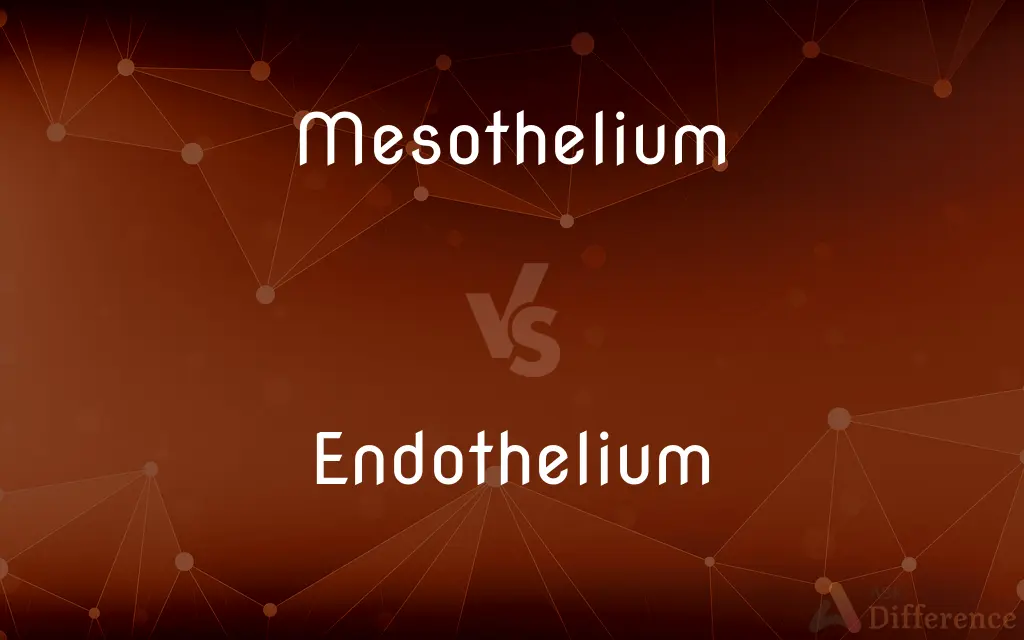Mesothelium vs. Endothelium — What's the Difference?
By Tayyaba Rehman & Urooj Arif — Updated on April 17, 2024
Mesothelium is a membrane that lines body cavities and covers internal organs, providing lubrication, whereas endothelium lines the interior of blood vessels and lymphatic vessels, regulating exchange and blood flow.

Difference Between Mesothelium and Endothelium
Table of Contents
ADVERTISEMENT
Key Differences
Mesothelium is a type of epithelium that lines the pleura, peritoneum, and pericardium, playing a key role in providing a slippery surface which is crucial for organ movements, while endothelium lines all blood vessels and lymphatic vessels, crucial for controlling vascular relaxation and contraction, blood clotting, and immune function.
The cells of the mesothelium are flat and form a simple, single layer of epithelial cells that secrete a lubricating fluid, whereas endothelial cells also form a simple layer but are involved in the filtration of blood, secretion of factors, and formation of new blood vessels.
Mesothelium is involved primarily in mechanical protection and creating a frictionless interface in body cavities, whereas endothelium acts as a semi-permeable barrier between the blood and the rest of the body tissue, which can selectively allow substances to pass through.
Mesothelium has a role in the pathological context too, as its cells can develop into malignant mesothelioma, often due to asbestos exposure, while endothelial dysfunction or damage is a key factor in the development of atherosclerosis and other cardiovascular diseases.
The health of the mesothelium is critical for reducing internal organ abrasion and facilitating free movement of the organs, especially the lungs and heart, while endothelial health is essential for maintaining overall cardiovascular health and regulating blood pressure.
ADVERTISEMENT
Comparison Chart
Location
Lines body cavities (pleura, peritoneum)
Lines blood and lymphatic vessels
Function
Lubricates and protects organs
Regulates exchange, filters blood, angiogenesis
Cell Type
Simple squamous epithelial cells
Simple squamous epithelial cells
Secretions
Lubricating fluid
Various molecules (e.g., nitric oxide)
Related Diseases
Mesothelioma (cancer)
Atherosclerosis, endothelial dysfunction
Compare with Definitions
Mesothelium
A layer of flat cells lining body cavities such as the chest and abdomen.
The mesothelium of the pleura helps in the smooth movement of the lungs during breathing.
Endothelium
A thin layer of cells that lines the interior surface of blood vessels and lymphatic vessels.
The endothelium helps regulate blood pressure through the release of vasodilators.
Mesothelium
A membrane that provides a protective, lubricating barrier around internal organs.
Damage to the mesothelium can cause painful inflammation.
Endothelium
Tissue that controls the passage of materials and the transit of white blood cells into and out of the bloodstream.
Endothelial cells can become leaky in inflammation, allowing more immune cells to pass through.
Mesothelium
Protective tissue that secretes a fluid that reduces friction.
The mesothelium secretes fluid that facilitates the free movement of abdominal organs.
Endothelium
Involved in the creation of new blood vessels, a process known as angiogenesis.
The endothelium releases factors that stimulate new blood vessel formation during wound healing.
Mesothelium
The epithelial component of serous membranes in the body.
The peritoneal mesothelium is sensitive to irritants and infections.
Endothelium
Plays a crucial role in blood clotting and vascular tone.
Endothelial dysfunction can lead to increased risk of thrombosis.
Mesothelium
A structure involved in the cellular responses to injury and inflammation.
The mesothelium plays a role in the healing processes after surgical procedures.
Endothelium
The interface between circulating blood or lymph and the rest of the vessel wall.
The endothelium acts as a barrier and a gatekeeper in vascular biology.
Mesothelium
The mesothelium is a membrane composed of simple squamous epithelial cells of mesodermal origin, which forms the lining of several body cavities: the pleura (pleural cavity around the lungs), peritoneum (abdominopelvic cavity including the mesentery, omenta, falciform ligament and the perimetrium) and pericardium (around the heart). Mesothelial tissue also surrounds the male testis (as the tunica vaginalis) and occasionally the spermatic cord (in a patent processus vaginalis).
Endothelium
Endothelium is a single layer of squamous endothelial cells that line the interior surface of blood vessels, and lymphatic vessels. The endothelium forms an interface between circulating blood or lymph in the lumen and the rest of the vessel wall.
Mesothelium
The layer of flat cells of mesodermal origin that lines the embryonic body cavity and gives rise to the squamous cells of the peritoneum, pericardium, and pleura.
Endothelium
A thin layer of flat epithelial cells that lines serous cavities, lymph vessels, and blood vessels.
Mesothelium
(biology) A membrane of flat epithelial cells that lines the body cavity of embryos and forms the squamous cells of the peritoneum, pericardium, and pleura
Endothelium
(anatomy) A thin layer of flat epithelial cells that lines the heart, serous cavities, lymph vessels, and blood vessels.
Mesothelium
Epithelial mesoderm; a layer of cuboidal epithelium cells, formed from a portion of the mesoderm during the differetiation of the germ layers. It constitutes the boundary of the cŒlum.
Endothelium
The thin epithelium lining the blood vessels, lymphatics, and serous cavities. See Epithelium.
Mesothelium
Epithelium originating in the embryonic mesoderm; lines the primordial body cavity
Endothelium
An epithelium of mesoblastic origin; a thin layer of flattened cells that lines the inside of some body cavities
Common Curiosities
How does endothelium contribute to cardiovascular health?
The endothelium contributes to cardiovascular health by maintaining the flexibility of blood vessels and regulating blood flow.
What role does endothelium play in hypertension?
Endothelial dysfunction can lead to hypertension by impairing the ability of blood vessels to dilate properly.
Can the function of the mesothelium be restored after damage?
Restoration of mesothelium function after damage is limited and often does not fully return to normal, especially in cases of extensive injury or disease.
What is the primary function of the mesothelium?
The primary function of mesothelium is to provide a lubricating fluid that minimizes friction between internal body surfaces.
Can diseases of the mesothelium affect other organs?
Yes, diseases of the mesothelium, like mesothelioma, primarily affect the lungs but can influence other organs by disrupting the protective lining.
How is the mesothelium affected by asbestos?
Asbestos fibers can cause scarring and inflammation of the mesothelium, eventually leading to mesothelioma, a type of cancer.
What is the significance of endothelial angiogenesis in health?
Endothelial angiogenesis is crucial for wound healing and recovery from ischemic injuries by restoring blood supply.
How does the endothelium affect immune response?
The endothelium plays a key role in the immune response by regulating the movement of immune cells across the vessel wall into tissues.
Are there preventive measures for endothelial dysfunction?
Preventive measures include maintaining a healthy diet, regular exercise, and managing risk factors like diabetes and high cholesterol.
How are mesothelium and endothelium studied in medical research?
Both are studied in medical research to understand their roles in diseases and develop treatments for conditions like cancer and cardiovascular diseases.
Share Your Discovery

Previous Comparison
Nomadic vs. Sedentary
Next Comparison
Balustrade vs. HandrailAuthor Spotlight
Written by
Tayyaba RehmanTayyaba Rehman is a distinguished writer, currently serving as a primary contributor to askdifference.com. As a researcher in semantics and etymology, Tayyaba's passion for the complexity of languages and their distinctions has found a perfect home on the platform. Tayyaba delves into the intricacies of language, distinguishing between commonly confused words and phrases, thereby providing clarity for readers worldwide.
Co-written by
Urooj ArifUrooj is a skilled content writer at Ask Difference, known for her exceptional ability to simplify complex topics into engaging and informative content. With a passion for research and a flair for clear, concise writing, she consistently delivers articles that resonate with our diverse audience.















































